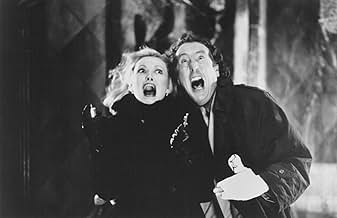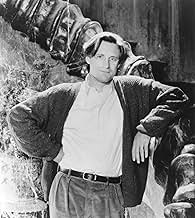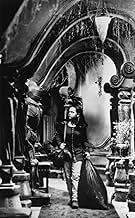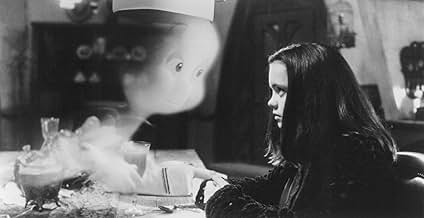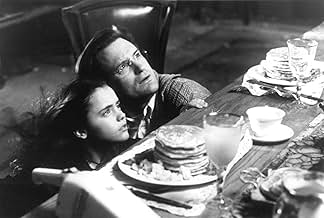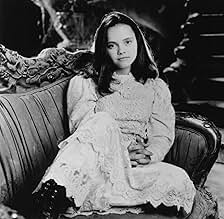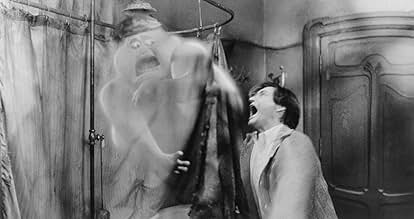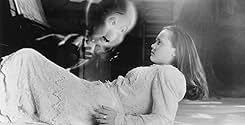Un experto paranormal y su hija se meten en una casa abandonada poblada por tres fantasmas traviesos y uno amistoso.Un experto paranormal y su hija se meten en una casa abandonada poblada por tres fantasmas traviesos y uno amistoso.Un experto paranormal y su hija se meten en una casa abandonada poblada por tres fantasmas traviesos y uno amistoso.
- Premios
- 5 premios ganados y 5 nominaciones en total
Fred Rogers
- Mr. Rogers
- (material de archivo)
- (as Mr. Rogers)
Doug Bruckner
- Reporter
- (voz)
- (as Douglas J.O. Bruckner)
Joe Nipote
- Stretch
- (voz)
Joe Alaskey
- Stinkie
- (voz)
Brad Garrett
- Fatso
- (voz)
- Dirección
- Guionistas
- Todo el elenco y el equipo
- Producción, taquilla y más en IMDbPro
Argumento
¿Sabías que…?
- TriviaThis is the first feature film to have a fully computer-generated visual effects character in a leading role.
- ErroresIn the classroom, Casper ties Amber's shoelaces together before anyone else's. When Amber stands up to protest the party being at Kat's house instead of hers, she doesn't trip over them. She sits back down, but when the bell rings and she gets up, she trips.
- Citas
Dr. Raymond Stantz: [runs out of the house frantic] Who you gonna call? Someone else.
- Créditos curiososThe globe in the Universal logo fades into a full moon above Whipstaff Manor.
- ConexionesEdited into Casper: Deleted Scenes (2003)
- Bandas sonorasCasper The Friendly Ghost
Written by Mack David and Jerry Livingston
Performed by Little Richard
Produced by Richie Zito and Little Richard
Arranged by Richie Zito
Opinión destacada
Forget the story. Forget the characters; forget even the kids and rent this just to be able to see Whipstaff Manor.
For me a film can be rewarding if just one element (in practical terms, it has to be an element I can recognize) is best in class. Here, it is the absolutely engaging set.
At the end of the 19th century, a style of art, essentially a fad, swept over Europe: Art Nouveau. This focused on natural forms and continuous lines. Done well in drawing and sculpture, its quite charming. At the same time, there was a crisis in architecture as the first real architects sought solutions to how internal space affects the psyche. For only a decade or so, architects tried to employ art nouveau in their work.
The problem is that the two just don't naturally mix: it's as if someone tried to do a swimmingpool production of Hamlet. But two geniuses partly succeeded in a few experiments: Horta in Brussels and Gaudi in Barcelona. In their lives their experiments were rejected by the public and critics. Today, they are among only a few valued gems of modern architectural history we have.
So much for background. What we have in Whipstaff Manor is a reworking of Gaudi, with some elements of Horta in entry and staircase. This is notable for a couple reasons:
---The primary mission of a film is to convey a tone, ideally an unfamiliar one. Sometimes cinematography is the tool of reliance, sometimes costumes, sometimes surreal plot twists, rarely acting posture. Rarely, rarely is the set the star. The goal of Gaudi was to (in a very literal sense) raise spirits by the form of the space. See how you feel in the bedroom/corridor and `livingroom' spaces. The attic was done by a lesser talent and the cellar isn't part of this discussion. But the main house draws on some deeply spooky center of the mind.
---The second notable comment is the sheer difficulty of what the set designers have done. Gaudi, an absolute master, had difficulty pulling off what he did. Here, the Casperites had an even greater challenge: when I go in a space, the relationship between me and the space is intimate; just a simple dialog. But when the space is presented through a medium, the designers have to dramatically exaggerate elements so the combined effect appears `normal.' Its the same as with what actors must do as compared to ordinary people you encounter; but an environment is more complex, more multidimensional, less semiotically loaded than a person. Mastering this greater palette of form is remarkable, and that's before you even accommodate the physical needs of production (camera placement, sound wiring...)
Check this out; it's interesting. Just based on the set, I place this in my best films list.
For me a film can be rewarding if just one element (in practical terms, it has to be an element I can recognize) is best in class. Here, it is the absolutely engaging set.
At the end of the 19th century, a style of art, essentially a fad, swept over Europe: Art Nouveau. This focused on natural forms and continuous lines. Done well in drawing and sculpture, its quite charming. At the same time, there was a crisis in architecture as the first real architects sought solutions to how internal space affects the psyche. For only a decade or so, architects tried to employ art nouveau in their work.
The problem is that the two just don't naturally mix: it's as if someone tried to do a swimmingpool production of Hamlet. But two geniuses partly succeeded in a few experiments: Horta in Brussels and Gaudi in Barcelona. In their lives their experiments were rejected by the public and critics. Today, they are among only a few valued gems of modern architectural history we have.
So much for background. What we have in Whipstaff Manor is a reworking of Gaudi, with some elements of Horta in entry and staircase. This is notable for a couple reasons:
---The primary mission of a film is to convey a tone, ideally an unfamiliar one. Sometimes cinematography is the tool of reliance, sometimes costumes, sometimes surreal plot twists, rarely acting posture. Rarely, rarely is the set the star. The goal of Gaudi was to (in a very literal sense) raise spirits by the form of the space. See how you feel in the bedroom/corridor and `livingroom' spaces. The attic was done by a lesser talent and the cellar isn't part of this discussion. But the main house draws on some deeply spooky center of the mind.
---The second notable comment is the sheer difficulty of what the set designers have done. Gaudi, an absolute master, had difficulty pulling off what he did. Here, the Casperites had an even greater challenge: when I go in a space, the relationship between me and the space is intimate; just a simple dialog. But when the space is presented through a medium, the designers have to dramatically exaggerate elements so the combined effect appears `normal.' Its the same as with what actors must do as compared to ordinary people you encounter; but an environment is more complex, more multidimensional, less semiotically loaded than a person. Mastering this greater palette of form is remarkable, and that's before you even accommodate the physical needs of production (camera placement, sound wiring...)
Check this out; it's interesting. Just based on the set, I place this in my best films list.
- tedg
- 24 may 2000
- Enlace permanente
Selecciones populares
Inicia sesión para calificar y agrega a la lista de videos para obtener recomendaciones personalizadas
Detalles
- Fecha de lanzamiento
- País de origen
- Sitio oficial
- Idioma
- También se conoce como
- Gasparín
- Locaciones de filmación
- Rockport, Maine, Estados Unidos(Anonymous)
- Productoras
- Ver más créditos de la compañía en IMDbPro
Taquilla
- Presupuesto
- USD 55,000,000 (estimado)
- Total en EE. UU. y Canadá
- USD 100,544,179
- Fin de semana de estreno en EE. UU. y Canadá
- USD 16,840,385
- 28 may 1995
- Total a nivel mundial
- USD 288,144,179
- Tiempo de ejecución1 hora 40 minutos
- Color
- Mezcla de sonido
- Relación de aspecto
- 1.85 : 1
Contribuir a esta página
Sugiere una edición o agrega el contenido que falta



